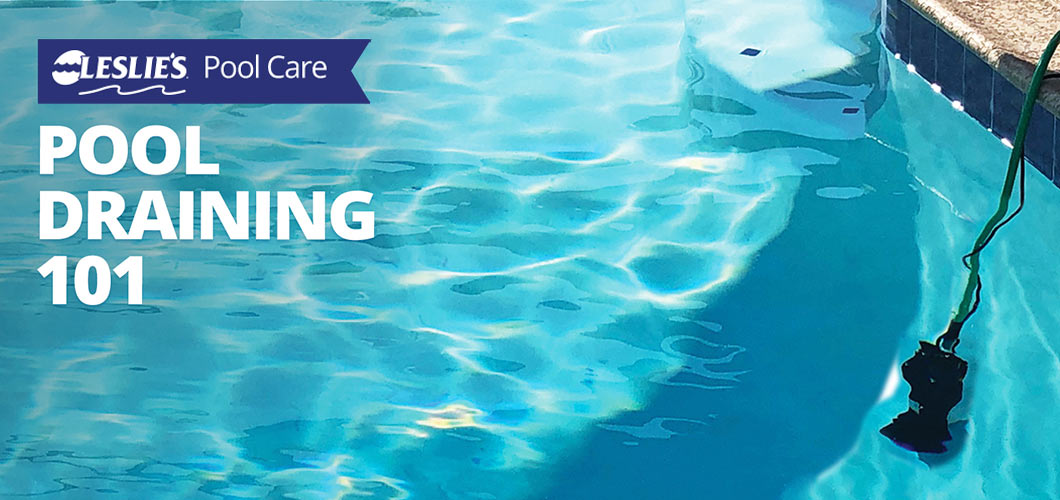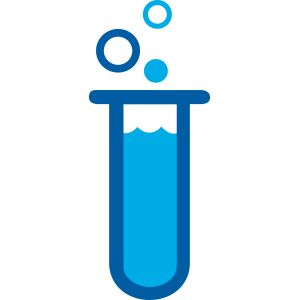
Pool Draining 101
So many of us dislike the thought of an empty swimming pool. We prefer seeing full, healthy, safe pools being enjoyed by many and as often as possible. However, pool maintenance is necessary, and sometimes draining the pool is required. But how to drain a pool properly and the key reasons to do a full pool drain, are important to understand. As your trusted pool care partner, the team at Leslie’s wants to make sure you know when draining your pool is the right call — and how to execute it properly.
Reasons to Drain Your Pool

Poor water quality, due to an overabundance of Total Dissolved Solids (TDS), or high levels of Cyanuric Acid (CYA), or high Calcium Hardness, is the most common reason for needing to drain a pool.

Even with proper and regular pool maintenance, it's often necessary to drain your pool — either completely or partially — every 3-5 years.
Draining your pool often isn't necessary, especially if you're following a proper and regular maintenance program. However, there are a few reasons that lead to a complete, or partial, pool drain.
Water Balance and Clarity Issues
The most common reason is an overabundance of Total Dissolved Solids (TDS). Over time, TDS levels slowly increase in your pool water, and once you reach about 2500 ppm, you start to lose the ability to balance the water. Your first response is likely to add more chemicals, but that will not solve the problem. Depending on the quality of your fill water and the quality of chemicals used, you typically add, you should expect to empty your pool every 3-5 years due to TDS.
Another reason for draining the pool is high Cyanuric Acid (CYA) or Calcium Hardness levels. CYA and excess calcium build up in the water and cannot be removed by the addition of chemicals. The most economical way to reduce CYA or Calcium Hardness is to partially empty the pool and add fresh water, which dilutes the levels in the water.
Routine Pool Maintenance
You might also need to empty your pool to do certain types of repair work on interior pool surfaces. This can include acid washing to remove stains and scale. Repairs and maintenance may also involve resurfacing, repainting, or fixing cracks in the walls. If you have a vinyl liner in need of replacement, this, too, calls for a complete pool drain.
Important Tips Before You Get Started:
- Check with your local municipality to find out when and where it is approved to remove your pool water. For example, most municipalities have ordinances against discharging water into storm drains.
- Consider the groundwater levels in your area. High groundwater levels can cause an empty inground pool to literally pop out of the ground. If high groundwater is present in your area, it is best to only partially empty your pool.
- Never completely drain a fiberglass or inground vinyl-lined pool. Doing so can damage the integrity of the pool surface or liner, resulting in bowing or cracking. The only time you should fully drain a vinyl pool is if you’re replacing the liner. Otherwise, the best practice is to partially drain these types of pools. Always complete partial drains by a foot of water at a time, or 1/3 of the water at a time.
- Turn off the electricity to your pump and pool light, as well as remove the trippers, prior to draining.
DIY TIP: If possible, drain the pool when the outside air temperature is less than 85°F. Spring is generally an ideal time to drain your pool.
How to Drain a Pool
There are a few things to keep in mind in order to drain your pool safely. Never use your pool pump to try to drain the pool. Inevitably, you will pull air into your suction line, the pump will lose its prime, and you will damage or burn up your pump. Always rent or purchase a submersible pump to drain the pool.
After removing the old water, you can refill the pool with water from your garden hose. To speed the water refill process, if possible, you may find it helpful to run two garden hoses simultaneously. It typically takes 14-16 hours to refill an average-sized pool with two hoses.
DIY TIP: For the fastest refill, look into a water hauling service to deliver water for your pool. Pool owners who rely on well water sources or those who have particularly hard water may want to take this route instead of refilling from their home’s water spigot.
Test your water immediately after refilling to balance and add start-up chemicals. You can also take a water sample to Leslie’s for a free AccuBlue water test. Leslie’s will test your water and provide the results with a customized recommendation for improving your water quality.
Not sure if your pool really needs draining, or have other questions? Visit your local Leslie’s to ask our team of experts. We are here to help you with every aspect of your pool maintenance — even a complete or partial pool drain.